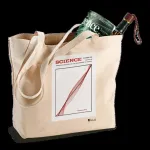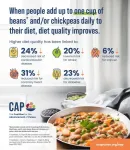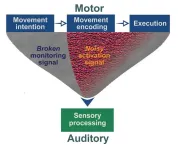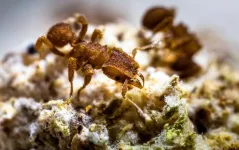(Press-News.org) COLUMBUS, Ohio – Researchers have developed a way to make one type of plastic material more durable and less likely to shed dangerous microplastics.
The study identified a secure way to attach chemical additives to polyvinyl chloride (PVC).
Found in everything from toys, construction supplies and medical packaging, PVC plastics currently rank third among the most used plastics worldwide. Despite its widespread use, pure PVC is brittle and sensitive to heat, and manufacturers can only utilize it after stabilizing its properties with other chemicals.
However, these additives, or plasticizers, are only a short-term fix for stabilizing PVC. Over time, plasticizers leach from the plastics, which allows the material to deteriorate into potentially hazardous organics and microplastics. Now, a team led by Christo Sevov, the principal investigator of the study and an associate professor in chemistry and biochemistry at The Ohio State University, found that using electricity to permanently affix those chemical additives can prevent such unwanted reactions.
“Instead of mixing in those chemicals, our method involves chemically bonding the plasticizer compound directly to PVC by grafting them onto the backbone of the polymer,” said Sevov.
Altering PVC molecules in this way allows for them to become more durable and resistant to chemical changes, eventually leading to materials with more robust properties.
“This is really one of the few examples that we have where there’s this much control over changing the properties of PVC,” said Sevov. “So this is the first step in controllably modifying PVC to give it properties you’re interested in, whether it’s hard, stretchy or soft.”
The team did run into some challenges; synthetic polymer modifications often fail because the reactions were originally developed for small-molecule analogs, not big-molecule analogs such as pure PVC. To solve this, researchers optimized the catalyst they used in their process, and through trial and error, were able to overcome the issues that arise when editing big molecules.
The study was recently published in the journal Chem.
Outside of making leaps in organic chemistry, the team’s work also has implications for the environment, as putting a cap on how quickly plastics degrade can do much to curb the release of microplastics — tiny pieces of plastic debris — into our surroundings.
Today, scientists know that these particles, which have been found to pollute the air, water and our food supply, are harmful both to humans and wildlife. The average person likely ingests between 78,000 and 211,000 of these particles every year.
But as experts are beginning to understand the long-term impact microplastics have on Earth, organic chemists are racing to find ways to phase them out of everyday life, said Sevov.
“Many chemists are shifting their efforts to studying big molecules and developing new chemistries for upcycling, recycling and modifying well-known polymers,” he said. For example, trying to recycle PVC products can cause further degradation to the material due to the high temperatures it takes to convert plastic into something else, so the process isn’t very efficient.
But using Sevov’s method, “You can potentially reuse the material many, many more times before it really begins to fall apart, improving its lifetime and reusability,” he said.
In the future, more control over which materials will be safe for consumers will come once efforts to fix PVC leakage can be reliably scaled up, something that the study emphasizes that, at the moment, is possible with their method alone.
“There’s no better way to do this on the scale you would need for commercial PVC modification because it is an immense process,” said Sevov. “There’s still a lot to play around with before we solve the microplastic situation, though now we’ve laid the groundwork for how to do it.”
Other Ohio State co-authors include Jordan L.S. Zackasee, Valmuri Srivardhan, Blaise L. Truesdell and Elizabeth J. Vrana. This work was supported by the Department of Energy’s Early Career Research Program.
#
Contact: Christo Sevov, Sevov.1@osu.edu
Written by: Tatyana Woodall, Woodall.52@osu.edu
END
Houston Methodist researchers will be part of a national consortium funded by an up to $49 million award from the U.S. Government’s Advanced Research Projects Agency for Health (ARPA-H) to develop a vaccine against two of the most common and destructive strains of herpesviruses that latently infect a majority of Americans and can lead to acute infections, multiple forms of cancer, autoimmune disease and birth defects.
The award is part of ARPA-H’s Antigens Predicted for Broad Viral Efficacy through Computational Experimentation (APECx) program and will fund the America’s SHIELD project ...
SAN ANTONIO, Oct. 3, 2024 – The School of Dentistry at The University of Texas Health Science Center at San Antonio (UT Health San Antonio) earned the first National Institutes of Health grant under its new Center for Pain Therapeutics and Addiction Research, addressing pain in patients with head and neck carcinoma.
The nearly $600,000 grant by the NIH’s National Institute of Dental and Craniofacial Research will address this critical pain issue that significantly impairs quality of life. Many head and neck carcinoma patients require opiate pain management, but tolerance develops quickly, requiring new pain ...
Public health degree programs provide key competencies demanded by employers, but graduate employability could be improved by using more real-time data from employer job postings, according to a new study at Columbia University Mailman School of Public Health. This could help public health schools and programs ensure that graduates obtain specific technical skills listed in job postings, meet current employer needs, and prepare graduates for the demands of today’s labor market. The findings are published in the American Journal of Public Health.
The competencies required for the ...
Since the 2020 murder by Minneapolis police of George Floyd brought nationwide calls for change amid concerns that prevailing practices were not grounded in evidence and created harm, policing has been in turmoil. Implementation science (IS) involves integrating effective and evidence-based innovations into routine practice in fields like health care. Yet despite its potential, IS—and specifically, evidence-based policing (EBP)—remain vastly understudied and unused in police settings. In a new article, researchers provide an orientation to these issues ...
Frothy or smooth, bitter or sweet, light or dark: There’s a beer for most palates. As people around the world pour over the best brews at Oktoberfest celebrations or ferment about their favorite fall-themed beers, three papers published in ACS journals crack open new insights into these beverages. And if you’re hop-ing to conduct studies to find which beer is good for what ales you, please drink responsibly. Reporters can request free access to these papers by emailing newsroom@acs.org.
Coriander’s origin changes beer flavor. Just like simmering a stew, brewing a beer with herbs and spices can enhance its flavor. A study in ACS Food Science ...
Washington, D.C. — The American Association for the Advancement of Science, one of the world’s largest general scientific societies and publisher of the Science family of journals, announces an external research project to help the organization reimagine AAAS.org as part of a website overhaul project, which recently kicked off. AAAS is seeking input from its key audiences, including reporters and public information officers, to better align the experience and content of the website. As AAAS embarks on the next ...
Looking deep into the early universe with NASA’s James Webb Space Telescope, astronomers have found something unprecedented: a galaxy with an odd light signature, which they attribute to its gas outshining its stars. Found approximately one billion years after the big bang, galaxy GS-NDG-9422 (9422) may be a missing-link phase of galactic evolution between the universe’s first stars and familiar, well-established galaxies.
“My first thought in looking at the galaxy’s spectrum was, ‘that’s weird,’ which is ...
Moscow, Idaho, October 3, 2024: New research showing the association between greater bean and pulse consumption and improved shortfall nutrient intakes and a higher diet quality in American adults will be presented during the Academy of Nutrition and Dietetics (the Academy) Food & Nutrition Conference & Expo (FNCE) 2024 in Minneapolis, MN. The poster session is scheduled for Tuesday, October 8, 2024, from 10:45 – 11:45 AM CT at the Minneapolis Convention Center.
Researchers assessed the effect of increased bean and pulse consumption, in the typical US dietary pattern, on shortfall ...
Auditory hallucinations are likely the result of abnormalities in two brain processes: a “broken” corollary discharge that fails to suppress self-generated sounds, and a “noisy” efference copy that makes the brain hear these sounds more intensely than it should. That is the conclusion of a new study published October 3rd in the open-access journal PLOS Biology by Xing Tian, of New York University Shanghai, China, and colleagues.
Patients with certain mental disorders, including schizophrenia, often hear voices in the absence of sound. Patients may fail to distinguish between their ...
When humans began farming crops thousands of years ago, agriculture had already been around for millions of years. In fact, several animal lineages have been growing their own food since long before humans evolved as a species.
According to a new study, colonies of ants began farming fungi when an asteroid struck Earth 66 million years ago. This impact caused a global mass extinction but also created ideal conditions for fungi to thrive. Innovative ants began cultivating the fungi, creating an evolutionary partnership that became even more tightly intertwined 27 million years ago and continues to this day.
In a paper published today, Oct. 3, in the journal Science, scientists at the Smithsonian’s ...





